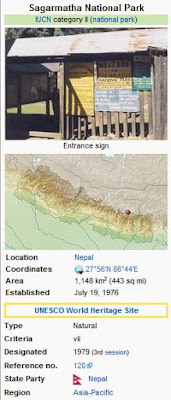 The
Sagarmāthā National Park (sagaramāthā rāstriya nikuñja) is a protected
area in the Himalayas of eastern Nepal that is dominated by Mount
Everest. It encompasses an area of 1,148 km2 (443 sq mi) in the
Solukhumbu District and ranges in elevation from 2,845 m (9,334 ft) to
8,848 m (29,029 ft) at the summit of Mount Everest. In the north, it
shares the international border with the Qomolangma National Nature
Preserve of Tibet and extends to the Dudh Kosi river in the south.
The
Sagarmāthā National Park (sagaramāthā rāstriya nikuñja) is a protected
area in the Himalayas of eastern Nepal that is dominated by Mount
Everest. It encompasses an area of 1,148 km2 (443 sq mi) in the
Solukhumbu District and ranges in elevation from 2,845 m (9,334 ft) to
8,848 m (29,029 ft) at the summit of Mount Everest. In the north, it
shares the international border with the Qomolangma National Nature
Preserve of Tibet and extends to the Dudh Kosi river in the south.The Sagarmatha National Park was established in 1976. In 1979, it became the country's first national park that was inscribed as a Natural World Heritage Site. In January 2002, a Buffer Zone comprising 275 km2 (106 sq mi) was added.[1] Under the Buffer Zone Management Guidelines the conservation of forests, wildlife and cultural resources received top priority, followed by conservation of other natural resources and development of alternative energy.
 Most
of the park area is very rugged and steep, and the terrain cut by deep
rivers and glaciers. The park contains the upper watershed of the Dudh
Kosi river basin and the Gokyo Lakes. Barren land above 5,000 m (16,000
ft) comprises 69% of the park while 28% is grazing land and the
remaining 3% is forested. Climatic zones include a forested temperate
zone, a subalpine zone above 3,000 m (9,800 ft), and an alpine zone
above 4,000 m (13,000 ft) that constitutes the upper limit of vegetation
growth. The nival zone starts at 5,000 m (16,000 ft).In the lower
forested zone, birch, juniper, blue pines, firs, bamboo and rhododendron
grow. Above this zone the vegetation is dwarf-sized or comprises
shrubs. As the altitude increases, plant life is restricted to lichens
and mosses. Plants cease to grow at about 5,750 m (18,860 ft), because
this is the permanent snow line in the Himalayas.
Most
of the park area is very rugged and steep, and the terrain cut by deep
rivers and glaciers. The park contains the upper watershed of the Dudh
Kosi river basin and the Gokyo Lakes. Barren land above 5,000 m (16,000
ft) comprises 69% of the park while 28% is grazing land and the
remaining 3% is forested. Climatic zones include a forested temperate
zone, a subalpine zone above 3,000 m (9,800 ft), and an alpine zone
above 4,000 m (13,000 ft) that constitutes the upper limit of vegetation
growth. The nival zone starts at 5,000 m (16,000 ft).In the lower
forested zone, birch, juniper, blue pines, firs, bamboo and rhododendron
grow. Above this zone the vegetation is dwarf-sized or comprises
shrubs. As the altitude increases, plant life is restricted to lichens
and mosses. Plants cease to grow at about 5,750 m (18,860 ft), because
this is the permanent snow line in the Himalayas.
Forests of pine and hemlock cover the lower elevations of the national park. At elevations of around 3,500 m (11,500 ft) and above, forests of silver fir, birch, rhododendron and juniper trees are found.The forests provide habitat to at least 118 species of birds, including Himalayan monal, blood pheasant, red-billed chough, and yellow-billed chough. Sagarmāthā National Park is also home to a number of rare mammal species, including musk deer, snow leopard, Himalayan black bear and red panda. Himalayan thars, langur monkeys, martens and Himalayan wolves are also found in the park.
The temperature and available oxygen decrease with altitude. Therefore, the animals that are found here are adapted to living on less oxygen and cold temperatures. They have thick coats to retain body heat. Some of them have shortened limbs to prevent loss of body heat. The Himalayan bears go into hibernation in caves during the winter when there is no food available.






0 comments:
Post a Comment